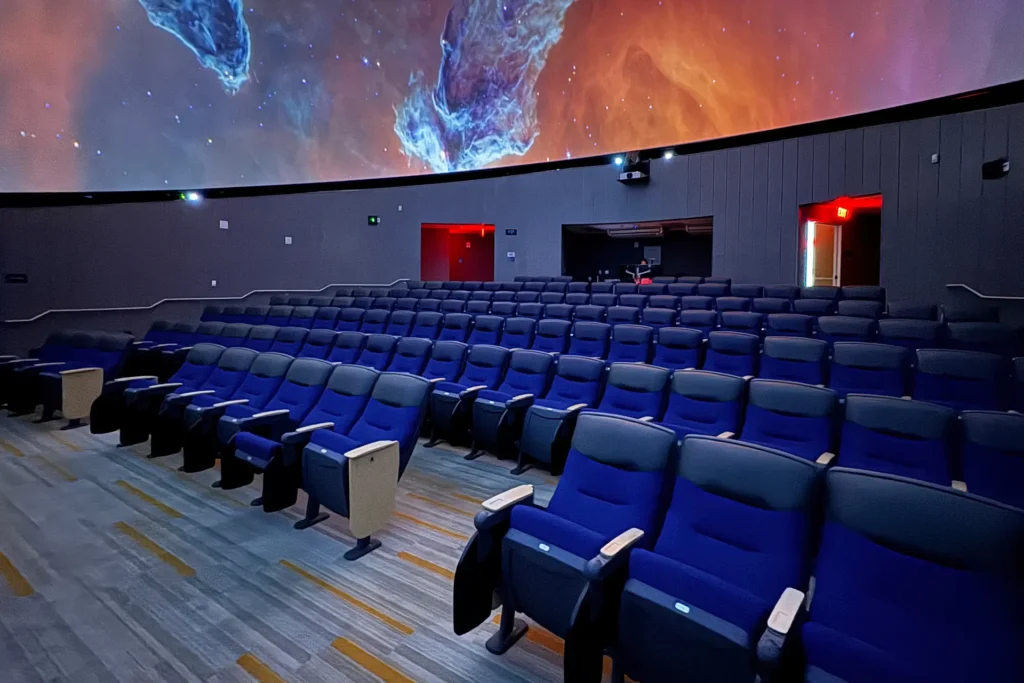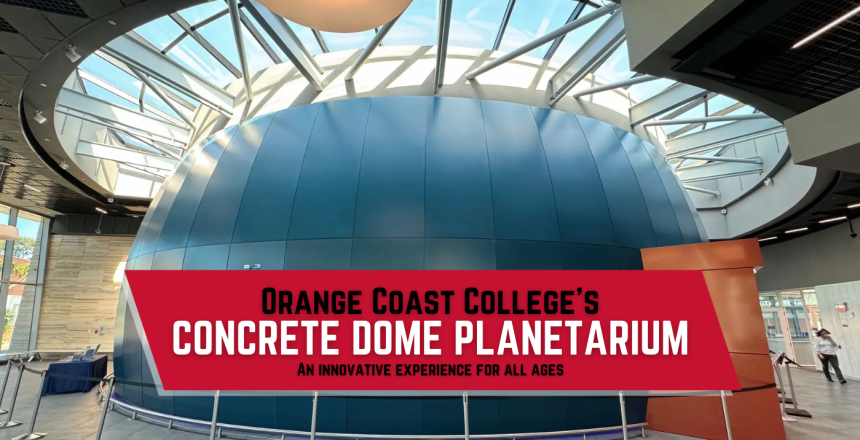Orange Coast College was one of the first colleges in California to have a planetarium on campus. Originally built in 1959 by a student of Frank Lloyd Wright, the first planetarium fell into disrepair decades later. Over 50 years later, the plans for a new concrete dome planetarium were drawn up.
Today, the new planetarium carries on the legacy of the original with state-of-the-art technology that brings its visitors face-to-face with the beauty and wonder of our universe.
About the OCC Concrete Dome Planetarium
Located in Costa Mesa, CA, Orange Coast College’s planetarium features a 70-foot diameter concrete dome at its center, with a 50-foot projection screen inside. The central dome is clad with blue stainless steel, an homage to the original copper-clad planetarium.

Surrounding the dome is a spiraling exhibit hall, including a tower that houses one of only a handful of the state’s Foucault pendulums. The spirals of the Milky Way Galaxy inspired the building’s design, providing an enticing visual from both the inside and the outside.
The dome planetarium holds 124 reclining seats under the 6-video 8K projection system. Set at a 12-degree angle, the theater creates an immersive experience that amazes visitors day and night.
But even with the grand results, the road to completion didn’t happen without challenges.
From Planning to Planets
Jessica Artinger, OCC Planetarium’s project manager, was a student at Orange Coast College when the initial blueprints were being passed around and discussed. At the time, local historians wanted to keep the original planetarium as a historical site. But renovation wasn’t possible due to the asbestos used in the original construction, leaving the building vacant for years.
According to Jessica, “The building hadn’t been used as a functioning planetarium for decades and was really only useful for storage. I was able to help the college convince historians of the importance of the new planetarium and how it would help students on their educational journeys.”
With Jessica’s encouragement, the planetarium broke ground in 2016. The 10-year planning and development had finally advanced to construction.
In March 2019, the OCC Planetarium opened its doors to the public. Since then, Jessica estimates that more than 17,000 visitors have come to see the exhibits and events the concrete dome planetarium offers throughout the week, including 9,000 K-12 students each year.
Orange Coast College Planetarium Exhibits and Programs

The Dome Theatre
The 360º dome experiences at the OCC Planetarium offer immersive journeys through space, but visitors can also catch “Lazerdome” shows synced to classic rock music, sea life films, and Mesmerica 360, a special film featuring music by Grammy-winning composer James Hood.
Science on a Sphere
The National Oceanic and Atmospheric Association helped design a unique data-driven exhibit that projects images of Earth onto a sphere. The exhibit provides a clear visual of several different phenomena, from weather and climate to geographical and anthropological information.
SOS Explorer
If the curated experience of Science on a Sphere doesn’t whet your appetite for knowledge, you can jump onto the Science on a Sphere Explorer (SOSx) stations to go deeper into the data provided through NOAA. These standalone stations allow visitors to dig through visual information to go even deeper, including flight paths and migration patterns.
Meteorites!
The planetarium hosts a collection of meteorites, including both lunar and martian specimens, as well as a large piece of the meteorite that created the Barringer Crater in Winslow, Arizona.
Skywatchers
Each Saturday evening, the public is invited to join planetarium staff in this real-time exploration of the night sky. From constellations and celestial bodies above the planetarium to explorations of nebulae, this regularly updated show provides wonders on a weekly basis.
K-12 Programming
Every year, nearly 10,000 school-age students wander through the planetarium and experience the night sky in ways that aren’t possible with Costa Mesa’s urban evenings. The massive dome screen provides a pristine canvas to explore the furthest reaches of our universe, as well as the phenomena we see right here with the naked eye.
Why Build a Concrete Dome Planetarium?
There is no doubt that the OCC Planetarium is striking, but the concrete dome at its center provides much more than eye-catching looks.
The construction process, which includes an inflated airform shell with steel-reinforced concrete and spray foam insulation, provides a nearly perfect geometric shape to mount the framing for the projection screens. That same shell also keeps the planetarium cool through the hot California summers. And the structure has been proven in lab tests to withstand some of the most powerful earthquakes we have on record.
This durable, economical, comfortable, and beautiful solution is perfect for immersive experiences like planetariums, and it’ll outlast the technology needed to bring people of all ages closer to the wonders of our universe.



